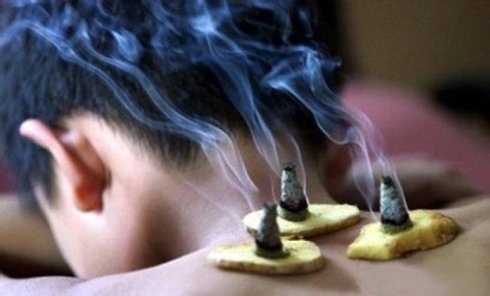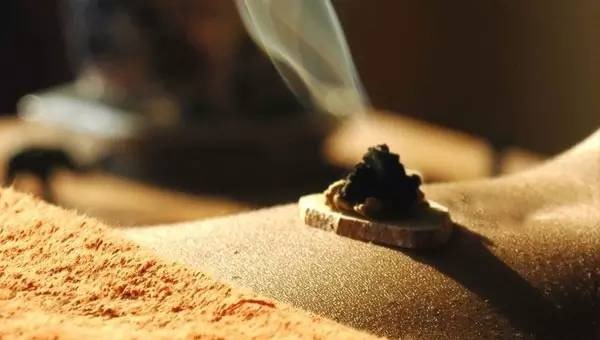Moxibustion with moxa cones refers to the method of handcrafting pure moxa wool into cones of varying sizes and igniting them on the acupuncture points for treatment. Commonly used moxa cones come in three sizes: small, medium, and large. Small moxa cones are the size of a grain of wheat, medium ones are the size of a lotus seed, and large ones are about half the size of an olive. Each burned moxa cone is termed a “moxa session,” and the number of sessions during moxibustion should be determined based on the patient’s specific condition. Moxibustion with moxa cones can be divided into two types: direct moxibustion and indirect moxibustion.
The main effects of moxibustion with moxa cones include promoting meridian circulation, regulating Qi flow and blood circulation, and dispelling dampness and cold. Promoting meridian circulation refers to the ability of moxibustion to warm and invigorate the body’s acupuncture points and meridians, treating various diseases caused by cold stagnation and obstruction of meridians. Regulating Qi flow and blood circulation means moxibustion has the function of adjusting Qi and blood, not only dispersing Qi but also boosting central Qi, thereby achieving the goal of health preservation. Additionally, moxibustion can dispel dampness and cold, also exhibiting a certain therapeutic effect on diseases caused by cold and dampness.
However, moxibustion with moxa cones also has some side effects and precautions. Due to the presence of fire during moxibustion, improper operation may lead to local burns, especially in patients with delayed reactions or reduced local sensitivity. Therefore, safety should be prioritized during moxibustion to prevent burns. Additionally, after moxibustion, it is important to keep warm, maintain a balanced diet, and drink plenty of water to accelerate the body’s metabolism and recovery. Moreover, scratching or rubbing the treated area should be avoided to prevent infection.
Manufacture and Application of Moxa Cones
To make moxa cones, moxa wool is rolled into spindle shapes using the thumb and forefinger, then firmly compressed onto a flat surface using the thumb, forefinger, and middle finger. Moxa cones have a pointed top and a rounded bottom, forming a conical shape, and are available in three sizes: large, medium, and small. Large moxa cones are about the size of a broad bean, medium ones are about the size of a jujube seed, and small ones are about the size of a grain of wheat. Each burned cone is termed a “moxa session.” The size and number of cones used during moxibustion should be flexibly adjusted based on the patient’s condition, the location and method of moxibustion, and the patient’s constitution. Generally, robust individuals are suited to large moxa cones with more sessions, while weaker individuals are suited to small moxa cones with fewer sessions. For those with Yang deficiency and cold syndrome, large moxa cones with more sessions are recommended, while for those with Yin deficiency and heat syndrome, small moxa cones with fewer sessions are advised. The choice of moxa cone size may also vary depending on the thickness of the muscles in the treated area. For areas with thick muscles, such as the back and thighs, large or medium moxa cones with more sessions are preferred, while for areas with thinner muscles, such as the wrists and ankles, small moxa cones with fewer sessions are recommended. Due to the thin and sensitive skin, small moxa cones with fewer sessions are suitable for treating the head and face.

Moxibustion with moxa cones, as a natural therapy, has various benefits such as promoting meridian circulation, dispelling dampness and cold, and regulating Qi and blood. However, proper operation and safety precautions should be observed to avoid adverse reactions such as burns. Therefore, it is advisable to seek advice and guidance from professional traditional Chinese medicine practitioners before undergoing moxibustion with moxa cones to ensure the safe and effective enjoyment of its benefits.
Moxa-Cone Moxibustion Methods
Moxibustion with moxa cones encompasses two main categories: direct moxibustion and indirect moxibustion.
Direct Moxibustion
Direct moxibustion involves placing the moxa cone directly on the skin and igniting it for treatment, also known as open moxibustion or skin-contact moxibustion. In clinical practice, it can be divided into suppurative moxibustion and non-suppurative moxibustion.

Suppurative moxibustion, also known as scar moxibustion, belongs to the scarring moxibustion method. A moxa cone the size of a broad bean or jujube seed is directly placed and ignited on the acupoint. Before moxibustion, attention should be paid to the patient’s posture and the accuracy of the acupoint location. After local disinfection, the area can be coated with garlic juice or vaseline to enhance the moxa’s adhesion to the skin. When the moxa cone burns close to the skin, patients usually experience severe pain due to the heat. To alleviate the pain, the affected area can be gently tapped, or anesthesia can be applied. After each moxibustion session, remove the ashes and repeat the process. Once the required number of sessions is completed, anti-inflammatory ointment can be applied to the acupoints and changed daily. It takes about a week for suppuration to form moxibustion scars. This method is suitable for conditions of deficiency-cold syndrome, while it is not suitable for conditions of actual heat or deficiency-heat syndrome. It is not recommended for use on the head, face, or neck, and excessive use of acupoints should be avoided. Using small moxa cones the size of a grain of wheat for moxibustion results in less pain and can be done continuously for 3-7 sessions without the need for ointment application after moxibustion, known as wheat grain moxibustion, which is suitable for individuals with both Qi and blood deficiencies.
Non-suppurative moxibustion, also known as scarless moxibustion, belongs to the mild moxibustion method. After igniting the moxa cone, when the patient feels the heat, the moxa cone is immediately removed or extinguished using tweezers. Moxibustion is continued for 3-7 sessions until local erythema appears. There are no moxibustion scars after treatment, making it more acceptable to patients.
Indirect Moxibustion
Indirect moxibustion involves using a barrier such as medicine between the moxa cone and the skin, also known as separated moxibustion. Common methods include:
Ginger-separated moxibustion: Fresh ginger is cut into slices about 2 centimeters thick, with several holes pierced in the middle using a needle. The ginger slice is placed on the acupoint, and the moxa cone is ignited on top of the ginger slice for moxibustion. This method is suitable for conditions such as wind-cold cough, deficiency-cold abdominal pain, vomiting, diarrhea, and wind-cold dampness impediment.
Garlic-separated moxibustion: A single-headed garlic clove is cut into slices about 1 centimeter thick, with several holes pierced in the middle using a needle. The garlic slice is placed on the acupoint, and the moxa cone is ignited on top of the garlic slice for moxibustion. Each acupoint can be moxibusted for 5-7 sessions, with sessions spaced 2-3 days apart. This method is suitable for conditions such as carbuncles that have not ulcerated, scrofula, and pulmonary tuberculosis caused by cold and dampness turning into heat.
Salt-separated moxibustion: Dry salt blocks are ground into fine powder and spread over the navel, with ginger slices and moxa cones placed on top of the salt for moxibustion. This method is suitable for conditions such as cold syndrome vomiting, abdominal pain, urinary retention, and coldness in the limbs caused by obstructed Qi deficiency. This method has the effect of warming Yang to rescue collapse.
